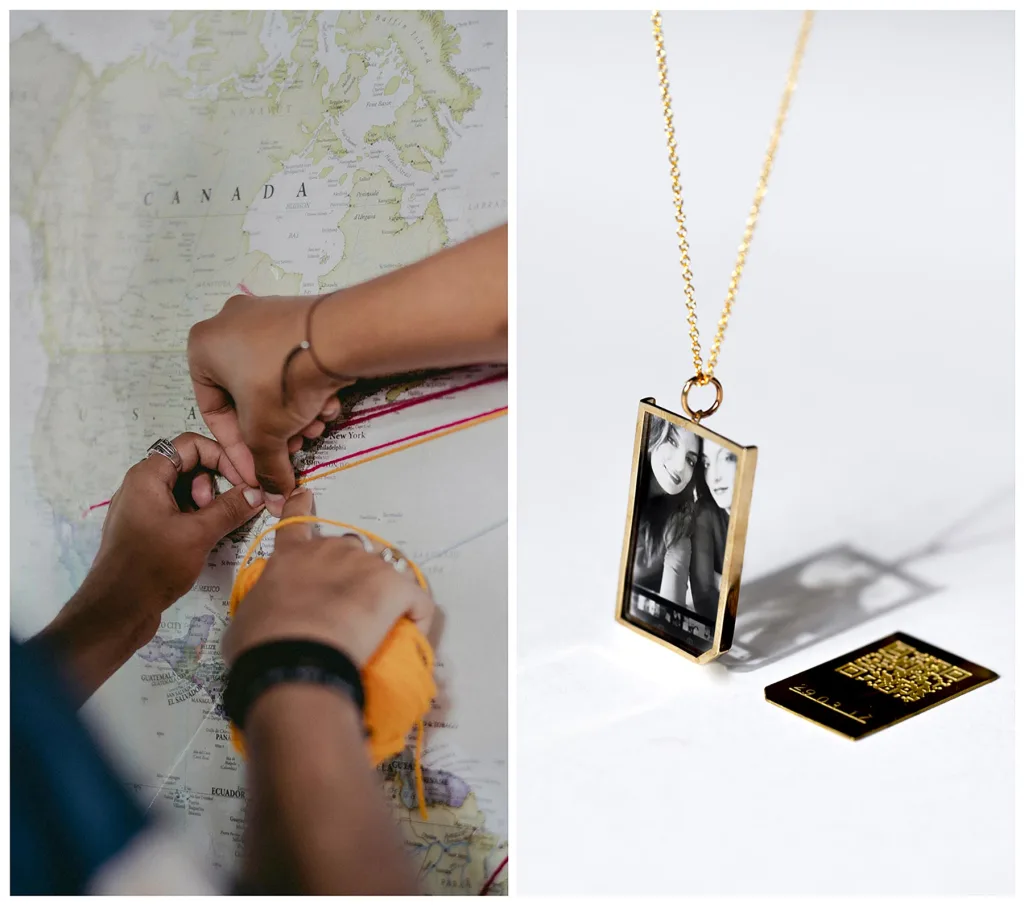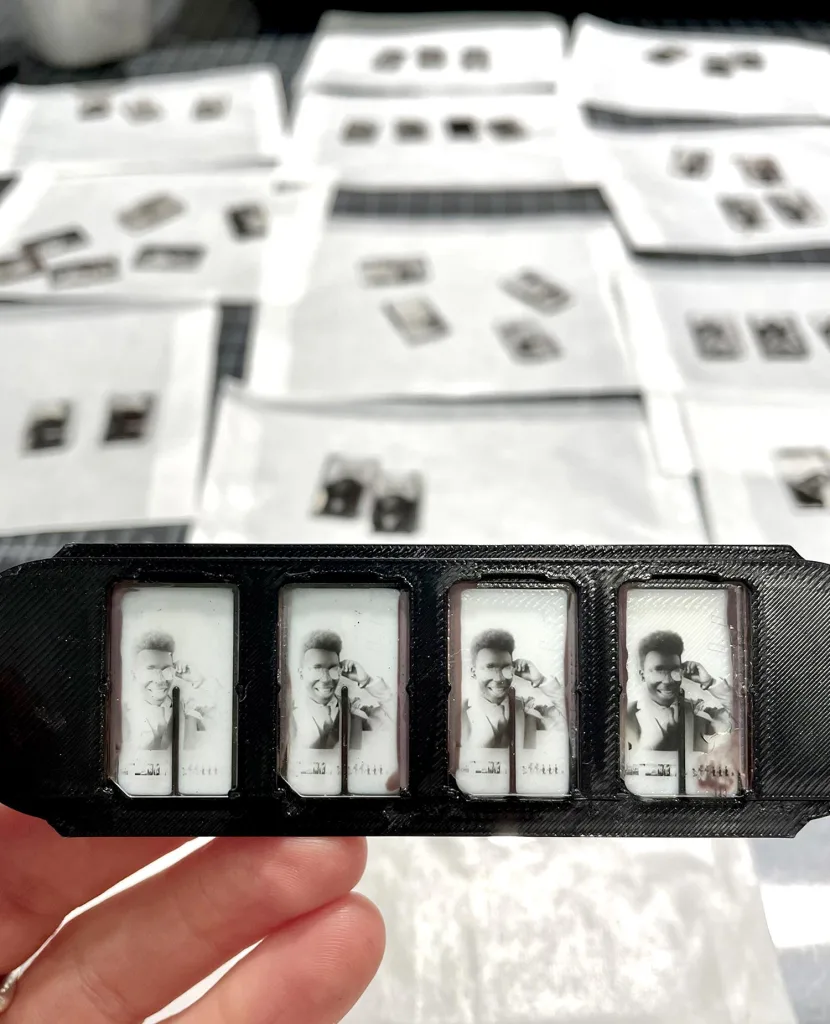How one artist is using the dying SIM card to tell refugees’ stories
Every refugee has a different story to tell, yet one tiny artifact connects them all. A SIM card measures less than an inch, but it can hold an entire world. In the U.S., SIM cards are slowly being replaced with e-SIM s. Still, physical SIM cards remain crucial for refugees, asylum seekers, and migrants who need them to stay connected with family back home while navigating life in their new country. Without a SIM card, refugees cannot make phone calls, access public services, or even get directions like Google Maps. “[A sim card] gives you an identity in a new place,” says artist, photographer and anthropologist Liz Hingley. For Hingley, the SIM card represents more than just a piece of technology, it’s an overlooked symbol of connection and belonging. Over the past eight years, she has explored this idea through an initiative called The SIM Card Project. As part of this project, she has run more than 50 workshops with people who have migrated to countries like the UK, Italy, Greece, Spain, Finland, and the United States. [Photo: Liz Hingley for The Sim Project] In each workshop, participants gather for several hours and learn to transfer an image from their phone onto a tiny glass print that is shaped like a SIM card. (Hingley landed on this format after speaking with Syrian refugees about the role SIM cards can play in fostering independence, and published her findings in a paper in the journal Imaginations: Special Issue on Migrations.) People then transform these glass prints into a personal amulet that they can hang on their neck and take home. Another print is contributed to the Sim Project collection. This collection has become a rich archive of migration stories curated entirely by the people they represent. “It’s about democratizing archives, and realizing that, through these digital devices, [people] have a capacity to document their own lives,” says Hingley. Hingley is now displaying 1,028 unique glass prints in an exhibition at the Victoria and Albert Museum in London. Each print is shaped like a SIM card and assembled on windowpanes reminiscent of stained-glass artworks. The exhibition, titled Memories in Motion, is a landmark moment in the history of the project, but for its creator, “the soul” of the project remains the workshops: “The idea is to bring people together,” she says. [Photo: Liz Hingley for The Sim Project] To date, Hingley has worked with hundreds of displaced people, including teenage refugees, women who have been victims of human trafficking, and Syrians who fled the civil war. She says some people often choose portraits of loved ones, others pick screenshots of maps depicting contested borders like Palestine, WhatsApp conversations, images of ultrasounds, and even images of physical photographs that family members have passed onto them, and they have archived on their phone. “This is my very first picture, taken by the the person who gave me life, my dad. I hold it in my phone,” Chen, a participant from China, now living in London has said about the project during a workshop. “Here, my family is together on one screen, in different countries—Canada, Nigeria, UK and France. This is something that rarely happens in life or online,” said Nafisah, a participant from Nigeria, now living in London. [Photo: Liz Hingley for The Sim Project] Because making the artifact is a physical process where external factors like AC and humidity can influence the final look of the image, the process is always slightly different. But the concept remains the same. People are asked to take a screenshot of an image that lives in their phones and gives them a sense of belonging. In a dark room designed especially for the project, they then learn to convert that digital image into a physical one by projecting it onto light-sensitive glass and putting it through a chemical process. Once the glass is dry, they come back to polish the frame that will hold the glass, and hand stamp a number that is significant to them on a backplate, mirroring the international identification number on every SIM card. Until now, the artist has relied on various grants to fund the project, but she is now working on turning The Sim Project into a sustainable social enterprise. This would allow people and companies to book workshops (or team building events) and fund her work with refugees. The concept is in its early stages, but if you’d like to participate, you can read about it more on the project website.

Every refugee has a different story to tell, yet one tiny artifact connects them all. A SIM card measures less than an inch, but it can hold an entire world. In the U.S., SIM cards are slowly being replaced with e-SIM s. Still, physical SIM cards remain crucial for refugees, asylum seekers, and migrants who need them to stay connected with family back home while navigating life in their new country. Without a SIM card, refugees cannot make phone calls, access public services, or even get directions like Google Maps. “[A sim card] gives you an identity in a new place,” says artist, photographer and anthropologist Liz Hingley.
For Hingley, the SIM card represents more than just a piece of technology, it’s an overlooked symbol of connection and belonging. Over the past eight years, she has explored this idea through an initiative called The SIM Card Project. As part of this project, she has run more than 50 workshops with people who have migrated to countries like the UK, Italy, Greece, Spain, Finland, and the United States.

In each workshop, participants gather for several hours and learn to transfer an image from their phone onto a tiny glass print that is shaped like a SIM card. (Hingley landed on this format after speaking with Syrian refugees about the role SIM cards can play in fostering independence, and published her findings in a paper in the journal Imaginations: Special Issue on Migrations.) People then transform these glass prints into a personal amulet that they can hang on their neck and take home. Another print is contributed to the Sim Project collection.
This collection has become a rich archive of migration stories curated entirely by the people they represent. “It’s about democratizing archives, and realizing that, through these digital devices, [people] have a capacity to document their own lives,” says Hingley.
Hingley is now displaying 1,028 unique glass prints in an exhibition at the Victoria and Albert Museum in London. Each print is shaped like a SIM card and assembled on windowpanes reminiscent of stained-glass artworks. The exhibition, titled Memories in Motion, is a landmark moment in the history of the project, but for its creator, “the soul” of the project remains the workshops: “The idea is to bring people together,” she says.

To date, Hingley has worked with hundreds of displaced people, including teenage refugees, women who have been victims of human trafficking, and Syrians who fled the civil war. She says some people often choose portraits of loved ones, others pick screenshots of maps depicting contested borders like Palestine, WhatsApp conversations, images of ultrasounds, and even images of physical photographs that family members have passed onto them, and they have archived on their phone.
“This is my very first picture, taken by the the person who gave me life, my dad. I hold it in my phone,” Chen, a participant from China, now living in London has said about the project during a workshop. “Here, my family is together on one screen, in different countries—Canada, Nigeria, UK and France. This is something that rarely happens in life or online,” said Nafisah, a participant from Nigeria, now living in London.

Because making the artifact is a physical process where external factors like AC and humidity can influence the final look of the image, the process is always slightly different. But the concept remains the same. People are asked to take a screenshot of an image that lives in their phones and gives them a sense of belonging. In a dark room designed especially for the project, they then learn to convert that digital image into a physical one by projecting it onto light-sensitive glass and putting it through a chemical process. Once the glass is dry, they come back to polish the frame that will hold the glass, and hand stamp a number that is significant to them on a backplate, mirroring the international identification number on every SIM card.
Until now, the artist has relied on various grants to fund the project, but she is now working on turning The Sim Project into a sustainable social enterprise. This would allow people and companies to book workshops (or team building events) and fund her work with refugees. The concept is in its early stages, but if you’d like to participate, you can read about it more on the project website.






















